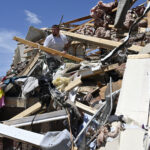According to catastrophe risk modeling firm AIR Worldwide (AIR), Hurricane Norbert gained strength and arrived on the southwest coast of Mexico’s Baja Peninsula at 9:30 a.m. local time (PDT) Saturday near Puerto Charley as a Category 2 hurricane with maximum sustained winds at landfall of 105 mph. Norbert maintained hurricane status as it crossed the Baja Penninsula and Gulf of California, making a second landfall in Mexico’s Sonora state at around 8:00 p.m. local time as a Category 1 storm with maximum sustained winds of near 85 mph. Given both of Norbert’s landfalls were along sparsely populated rural areas with only a small percentage of properties carrying insurance, AIR does not expect significant insured losses.
“Norbert’s intensity fluctuations over the last several days have kept forecasters busy,” said Dr. Tim Doggett, Senior Research Scientist at AIR Worldwide. “Norbert had been a powerful Category 4 storm with winds of 135 mph. Just 24 hours later, Norbert underwent an eyewall replacement and weakened to a Category 2 hurricane. By Friday, satellite images showed a double eyewall and estimates of wind speed had dropped further to 85 mph—Category 1 on the Saffir-Simpson scale. Still, forecasters were openly acknowledging the considerable uncertainty in their estimates, given their source; aircraft reconnaissance missions in the Eastern Pacific are far less frequent than in the North Atlantic and intensity estimates are therefore largely satellite-derived.”
By 2:00 a.m. local time on Saturday, as it approached the coast of Baja, the NHC determined that Norbert was once again a major hurricane with sustained winds of 115 mph. But 6 hours later, satellite images showed a degradation of the eye and Norbert finally made landfall at about 9:30 a.m. local time (PDT) near Puerto Charley as a Category 2 storm.
“Fortunately, Norbert’s landfall location was along a sparsely populated stretch of the coast about 145 miles northwest of the resort destination of Cabo San Lucas,” continued Dr. Doggett. “Nevertheless, Norbert was a large system at landfall and homes in Puerto San Carlos, some 40 miles west-northwest of Puerto Charley, were reportedly knee-deep in water from the system’s torrential rains. Roofs were blown off of homes and trees were downed in towns and villages across the region. Authorities evacuated hundreds of people from poorly constructed wood and sheet metal homes.”
Norbert maintained hurricane status as it crossed the Baja Penninsula and Gulf of California, making a second landfall in Mexico’s Sonora state at around 8:00 p.m. local time as a Category 1 storm with maximum sustained winds of near 85 mph. While crops in Sonora and Sinaloa — the state adjacent and to the south of Sonora –are likely to suffer from Norbert’s winds and rain, damage to insured properties in this largely agricultural and sparsely populated region is likely to be minimal.
Dr. Doggett continued, “As Norbert continued its path inland, the Sierra Nevada mountain range quickly impacted the organization of the system, decoupling the surface-level circulation from the mid- and upper-level circulations. Norbert is now a tropical storm moving to the northeast at near 20 mph. After further weakening, the remnants of Norbert will be over northwest Mexico later this morning and over western Texas and New Mexico later today, areas of which may receive up to 2 inches of rainfall.”
Source: AIR Worldwide.
Was this article valuable?
Here are more articles you may enjoy.

 Central US Severe Weather Outbreak Caused Billions in Damages, AccuWeather Says
Central US Severe Weather Outbreak Caused Billions in Damages, AccuWeather Says  DIY Home Inspections? They Are Taking Over, Firms Say
DIY Home Inspections? They Are Taking Over, Firms Say  Plane Crashes into San Diego Neighborhood, Setting Homes And Vehicles on Fire
Plane Crashes into San Diego Neighborhood, Setting Homes And Vehicles on Fire  Report Shows Cargo Theft Risk at All-Time Highs as Memorial Day Weekend Nears
Report Shows Cargo Theft Risk at All-Time Highs as Memorial Day Weekend Nears 